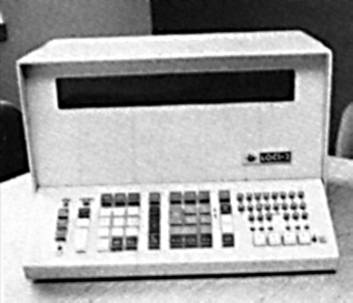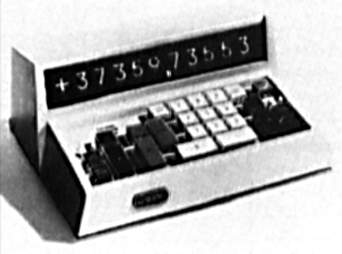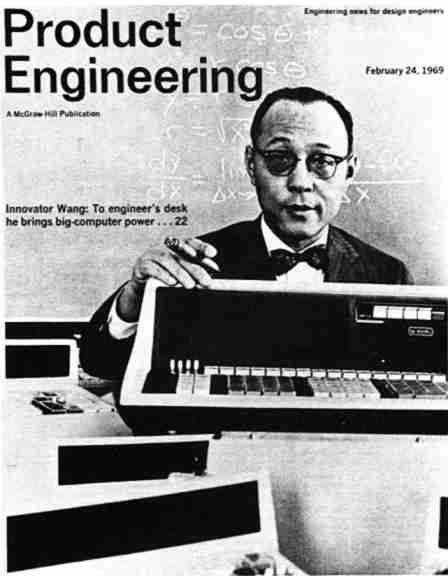| An Wang - The Man Who Might Have Invented The Personal Computer |
| Written by Historian | ||||||
Page 2 of 2
Calculating computersThe real breakthrough came when Wang realised that engineers and scientists needed a good desktop calculator. The current generation of machines were slow and couldn't work out the scientific functions that were needed. His bright idea was to use a factor-combining method for working out logarithms and to base the whole machine on this principle. Factor-combining algorithms can compute functions like log, sin and cos using nothing but addition, shifts and a lookup table. These are ideal for machines that don't have a hardware multiplier. The result, the LOCI, was very much easier to use and cheaper than a computer and it sold in large numbers to a scientific and engineering community that was still desperate for computational power. The idea was so good that even years later his competitors were still wondering how the LOCI could calculate logarithms with so little electronics!
The LOCI calculator that started Wang on the road to being a computer company.
What is surprising is that even in 1965 it was still believed that there was only a limited market for computers. Wang didn't want to get involved in building a minicomputer because he really didn't have any idea that there was a market for such a product - but the huge success of LOCI proved that there was for sophisticated calculators. Over time the LOCI and the other calculators that Wang designed grew more and more to look like minicomputers - they were programmable, they had I/O devices and they were modular. Why then did Wang carry on selling them as "calculators"? Perhaps the answer is that he had noticed the simple fact that once you mentioned the word "computer" management took notice and called in the accountants and called for proposals, studies and tenders. By selling his machines as calculators he short-circuited management's attempts to control computers and allowed the engineers and scientists to buy what amounted to a minicomputer in stages without having to seek approval from higher up! Interestingly a similar phenomena in the 80s got microcomputers into companies past the eyes of the data managers who were still totally preoccupied by their mainframes. Wang Laboratories continued to build calculators. The model 300 was even easier to use and more successful than the LOCI. Later he became convinced that the ultimate easy-to-use calculator would be a machine that could be programmed in Basic - then a new language.
The LOCI's successor - the much easier to use 300
The Wang 700 was modelled on the IBM 360 system architecture and the 3300 was the first to use Basic. The Wang 2200 was clearly a minicomputer and was special because it had Basic in ROM. You switched it on and you could run Basic programs without having to spend tens of minutes loading the system. Clearly a minicomputer and yet Wang still insisted on calling it a "computing calculator" to avoid setting off the alarm bells!
Wang's first computer, the 700
By 1971 the writing for the calculator market was on the wall but many did not want to know. Wang predicted and understood what LSI (large scale integration) chips would do to his profitable market. The chip manufacturers would control the price of chips and the calculator companies would be at their mercy. He decided to get out of calculators at a time that most of the company's revenues were generated by them - a brave move. The Wang word processorsWang decided that word processing was the next step and he build dedicated word processing hardware long before VDU displays made the task easier and friendlier. He was in direct competition with IBM but he used IBM Selectric typewriters as the output device. Sales were lost when these didn't perform to standard. Wang wasn't surprised when he discovered that a stabilizing spring was missing from all Selectrics sold to OEMs. With the spring in place the machine worked and sold well. Later word processors used VDU displays and were considered by many to be the best possible. Even though Wang had predicted correctly the effect that LSI chips would have on the calculator market he didn't guess that the eventual result would be the personal computer. The days of the dedicated word processor were numbered and Wang Laboratories went into decline despite his best efforts. He died in 1990 before the worst of the cutbacks had taken effect. An Wang was a cautious man who took business a step at a time and always weighed up the risks - a Confucian philosopher of the computer industry. He undoubtedly built the first desktop computers but had the good business sense not to draw attention to this fact. Related ArticlesHoward Aiken and the Harvard Mark I Thomas J Watson Jr and the IBM 360 Fifty Years On Thomas J Watson Sr, Father of IBM
To be informed about new articles on I Programmer, sign up for our weekly newsletter, subscribe to the RSS feed and follow us on Facebook or Linkedin.
Comments
or email your comment to: comments@i-programmer.info <ASIN:0887309895> <ASIN:1583482660> <ASIN:1576753050>
|
||||||
| Last Updated ( Friday, 03 March 2023 ) |




